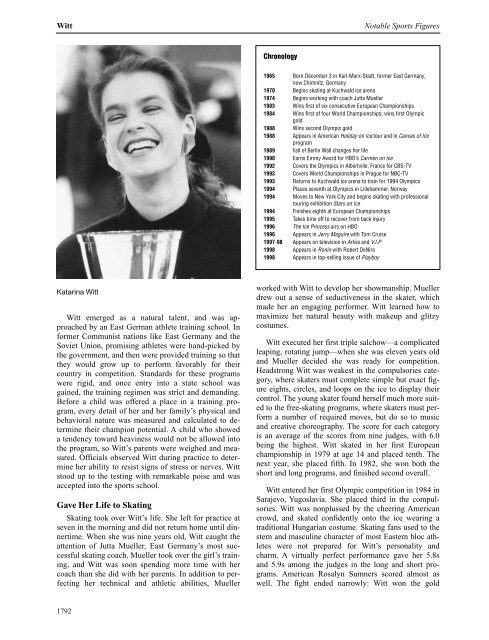Frank Thomas
Frank Thomas
Frank Thomas
Create successful ePaper yourself
Turn your PDF publications into a flip-book with our unique Google optimized e-Paper software.
Witt Notable Sports Figures<br />
Katarina Witt<br />
Witt emerged as a natural talent, and was approached<br />
by an East German athlete training school. In<br />
former Communist nations like East Germany and the<br />
Soviet Union, promising athletes were hand-picked by<br />
the government, and then were provided training so that<br />
they would grow up to perform favorably for their<br />
country in competition. Standards for these programs<br />
were rigid, and once entry into a state school was<br />
gained, the training regimen was strict and demanding.<br />
Before a child was offered a place in a training program,<br />
every detail of her and her family’s physical and<br />
behavioral nature was measured and calculated to determine<br />
their champion potential. A child who showed<br />
a tendency toward heaviness would not be allowed into<br />
the program, so Witt’s parents were weighed and measured.<br />
Officials observed Witt during practice to determine<br />
her ability to resist signs of stress or nerves. Witt<br />
stood up to the testing with remarkable poise and was<br />
accepted into the sports school.<br />
Gave Her Life to Skating<br />
Skating took over Witt’s life. She left for practice at<br />
seven in the morning and did not return home until dinnertime.<br />
When she was nine years old, Witt caught the<br />
attention of Jutta Mueller, East Germany’s most successful<br />
skating coach. Mueller took over the girl’s training,<br />
and Witt was soon spending more time with her<br />
coach than she did with her parents. In addition to perfecting<br />
her technical and athletic abilities, Mueller<br />
1792<br />
Chronology<br />
1965 Born December 3 in Karl-Marx-Stadt, former East Germany,<br />
now Chimnitz, Germany<br />
1970 Begins skating at Kuchwald ice arena<br />
1974 Begins working with coach Jutta Mueller<br />
1983 Wins first of six consecutive European Championships<br />
1984 Wins first of four World Championships; wins first Olympic<br />
gold<br />
1988 Wins second Olympic gold<br />
1988 Appears in American Holiday on Ice tour and in Canvas of Ice<br />
program<br />
1989 Fall of Berlin Wall changes her life<br />
1990 Earns Emmy Award for HBO’s Carmen on Ice<br />
1992 Covers the Olympics in Albertville, France for CBS-TV<br />
1993 Covers World Championships in Prague for NBC-TV<br />
1993 Returns to Kuchwald ice arena to train for 1994 Olympics<br />
1994 Places seventh at Olympics in Lillehammer, Norway<br />
1994 Moves to New York City and begins skating with professional<br />
touring exhibition Stars on Ice<br />
1994 Finishes eighth at European Championships<br />
1995 Takes time off to recover from back injury<br />
1996 The Ice Princess airs on HBO<br />
1996 Appears in Jerry Maguire with Tom Cruise<br />
1997-98 Appears on television in Arliss and V.I.P<br />
1998 Appears in Ronin with Robert DeNiro<br />
1998 Appears in top-selling issue of Playboy<br />
worked with Witt to develop her showmanship. Mueller<br />
drew out a sense of seductiveness in the skater, which<br />
made her an engaging performer. Witt learned how to<br />
maximize her natural beauty with makeup and glitzy<br />
costumes.<br />
Witt executed her first triple salchow—a complicated<br />
leaping, rotating jump—when she was eleven years old<br />
and Mueller decided she was ready for competition.<br />
Headstrong Witt was weakest in the compulsories category,<br />
where skaters must complete simple but exact figure<br />
eights, circles, and loops on the ice to display their<br />
control. The young skater found herself much more suited<br />
to the free-skating programs, where skaters must perform<br />
a number of required moves, but do so to music<br />
and creative choreography. The score for each category<br />
is an average of the scores from nine judges, with 6.0<br />
being the highest. Witt skated in her first European<br />
championship in 1979 at age 14 and placed tenth. The<br />
next year, she placed fifth. In 1982, she won both the<br />
short and long programs, and finished second overall.<br />
Witt entered her first Olympic competition in 1984 in<br />
Sarajevo, Yugoslavia. She placed third in the compulsories.<br />
Witt was nonplussed by the cheering American<br />
crowd, and skated confidently onto the ice wearing a<br />
traditional Hungarian costume. Skating fans used to the<br />
stern and masculine character of most Eastern bloc athletes<br />
were not prepared for Witt’s personality and<br />
charm. A virtually perfect performance gave her 5.8s<br />
and 5.9s among the judges in the long and short programs.<br />
American Rosalyn Sumners scored almost as<br />
well. The fight ended narrowly: Witt won the gold

















